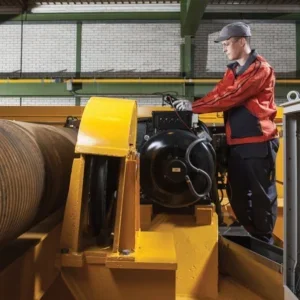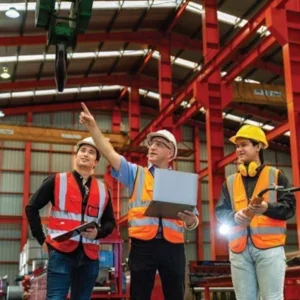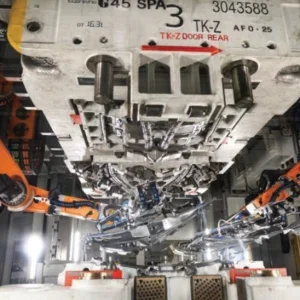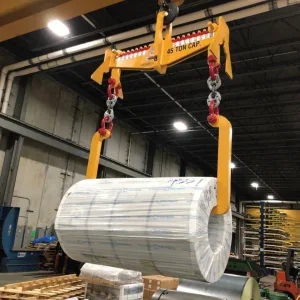According to Gavin Kemp of Morris Material Handling in the UK the change with most immediate impact will be brought about by the move away from personalised protection to general preventative measures: “Harnesses and lanyards have fairly widespread usage, and people have often used personal rather than collective protection. The new WAHR change this so the balance will change.”
“It’s also logical to say that if people move away from harnesses then powered access will have a greater role,” he adds.
Safety advisor Dave Vernon, of the UK’s Instant Training, echoes these comments. “The traditional method for repairing cranes might have been to use a ladder. Contractors will now use cherry pickers and scissor lifts more.”
Vernon also points out the change in focus of the new rules: “The major emphasis of the new regulations is planning and organisation and to assess the risks. What is the fall potential, what is its likelihood? Gone are the days when you just get the steps out.”
“There’s also a greater general emphasis on the management of health and safety,” he adds: “This means being aware of the alternatives and exploring what’s on the market. Although a growing number of people in these industries are aware of the issues, a lot of them are lacking practical advice on how to change and what to do and use.”
The impact of these changes will not be felt equally at all levels of industry, however. “In construction, if a company is complying with the old rules governing work at heights above 2m, it will mean little change for them. But other industries have not really focussed on fall prevention and protection.”
He continues: “In the engineering industry, for example, the larger organisations and companies are fully aware and have done a lot before the regulations to make sure they comply. It’s the smaller companies with fewer employees who spend less time working at height that are more of an issue. They’ll be saying ‘we’ve not had an accident so why should we change?’.”
Vernon adds: “We’ve been doing seminars to explain what’s required under the new legislation and offering practical advice about what you should do and how you should do it, as outlined in the hierarchical approach.”
Kemp also dismisses suggestions that the regulations are unnecessarily vague: “It’s not right to say the regulations aren’t prescriptive. They contain a hierarchy of what you can and can’t do in terms of the processes to be followed. You can’t just call 999 if there’s been an accident. The regulations make it clear you have to have a recovery procedure.”
Nevertheless he acknowledges that people need to know what they’re doing.
“It’s a process of education, which is what we’ve been doing through our seminars: explaining the regulations in detail, how to assess risks, how and when to use ladders, recommended toe board and hand or guard rail heights etc…”
According to Vernon, there is help available, however, and not just from training companies organising seminars. Manufacturers of access equipment also have a role to play: “A lot of them are taking measures to make kit safer.”
Mobile towers that now protect those erecting or dismantling them from the risk of falling, and the development of products like podium steps with handrails and guardrails are cases in point, he adds.
The view from abroad
The risks associated with working at height are shared around the world, but this does not mean that other countries have adopted the same approach, even if the motivation is the same.
Dennis Gonzalez, director of training at Crane America Services, says: “The requirements are pretty similar to those in the US. They don’t want you just walking round with harnesses on, although we’re crane people so we have to wear them when we’re repairing cranes. But it’s deemed preferable to use a manlift rather than just tying yourself to a building.”
According to Gonzalez, the regulations and standards that relate to work at height in the US date from the 1970’s and don’t actually dictate much of what is now recognised as best or even standard practice. Instead, this has been determined by insurance companies looking to protect themselves against claims brought against their customers.
In spite of this apparent lacuna, Gonzalez is not concerned that safe working at height has been compromised: “The relative safety of the US is fairly satisfying – it’s safe because it’s a litigious society. Companies won’t be insured if their work practices are unsafe.”
If an incident does happen, safety investigators have fairly wide-ranging powers to be able to enforce this non-prescriptive approach to legislation. “Safety investigators will be looking to see if there was an imminent danger, and if so what was done about it – if nothing or not enough was done there’ll be a fine. They don’t have pages and pages of procedures that they have to pick apart to see what was done wrong.”
In Germany, as in the US, there is a seemingly weak legal infrastructure governing work at height that has been supplemented by quasi-legislation. Unlike in the US, however, these quasi-regulations have not come from the insurance industry. Instead, they come from workers’ mutual societies.
Volker Goergen, head of a service cooperative called GKS-Guetegemeinschaft Kranservice says: “These regulations don’t have the status of law, but a judge looks at them as if they’re a law. If there’s been an accident and you haven’t considered these and taken them into
account then you have a big problem.”
According to Goergen, these guidelines for good practice are very prescriptive: “There are a lot of different books of these guidelines for different tasks. They are very precise and very specific, which is typical of Germany. Often we don’t do anything, but if we do something we do it to the Nth degree: if you work at 2m you must do this, if you’re repairing a crane or building a house you must do that… I don’t know if there’s anybody in Germany who knows them all.”
Holland’s approach seems to be the loosest of all. “I don’t know exactly how it’s written down in the UK but it seems like a reasonable approach,” says Bart Dieben, freelance crane engineer: “In Holland we also have requirements and courses for safe working in all sorts of environments – heights, confined spaces, with flammable substances.”
He continues: “These courses are good as they shift people’s responsibility higher up the levels within a business. When it comes to work at height the buck stops at the employer, although designers also have a responsibility.”
According to Dieben, responsibility for assessing and dealing with these kinds of risks should be at a management level: “There should be a
forum for workers to be able to raise concerns with the management. This is a general requirement under Dutch law (not just for work at height) in companies above a certain size.”
However, ensuring safe work at height is not just the responsibility of managers, he adds: “We’re also doing a lot of work to make sure people who do the work are responsible for themselves – making people aware of the need to personal protective equipment.”
The only concern Dieben has over this Anglo-Dutch approach is a lack of clarity:
“In Holland the regulations can be a bit vague. The general principle is to use your common sense, but this creates a problem when explaining the regulations to others and how you interpret them. If you’re going to be soft-handed like this you need to have specific advice for different jobs.”






